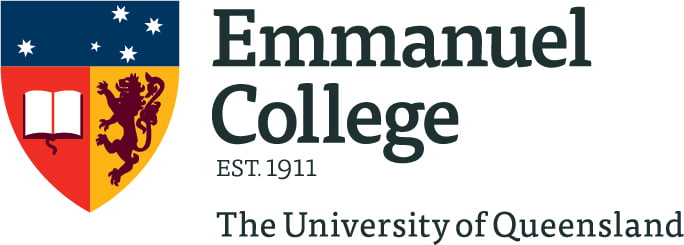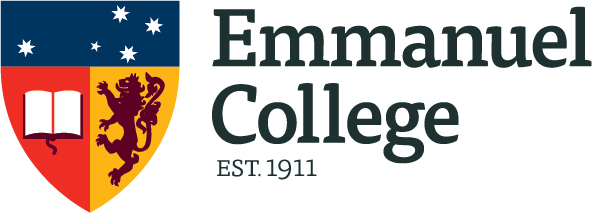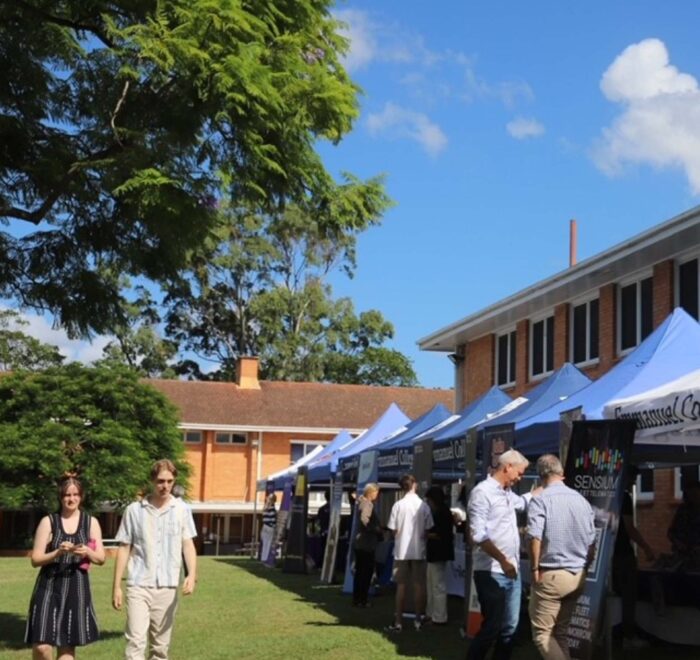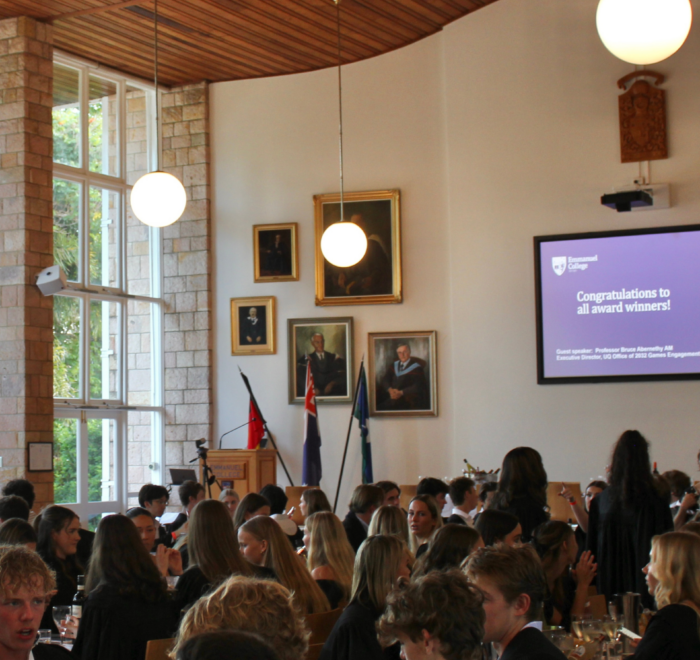The post-war years brought many changes and the 1950s were a time of significant social and cultural progress in Australia. Modernism had arrived and the new style of urban development, architecture and interior design signified a break with the past. The built form of houses, businesses, and institutions transformed in response to a modernising world.
After World War II, work recommenced on The University of Queensland site on the lands of the Turrbal and Jagera people. UQ relocated from Brisbane city to St Lucia progressively through the late 1940s and early 1950s. The sandstone buildings at the UQ campus, with their stripped classical style straddling classicism and modernism, encompassed both old and new forms.
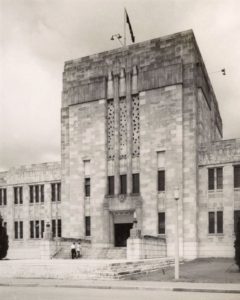
UQ Forgan Smith building in 1954
In contrast, the new Emmanuel College would embrace a new way of living and learning within the functionalism of modernity. Principal Henderson recorded that architects Goodsir and Carlyle submitted two plans: “One of a single great building and the other of some ten separate buildings connected within a great circle by a covered way. The latter plan was unanimously chosen”. The rationale was that this plan would encourage a sense of community and “bring students closer together and add to the home-away-from-home feeling. In one huge building, it is easy to envisage some shy and lonely students, whereas … all in each [smaller] building will come to know one another well”.
Building commenced mid-1954, funded through donations of £34,000 gifted by Presbyterian Church members and the broader College community, the sale of the Wickham Terrace site to establish St Andrew’s War Memorial Hospital for £64,649 (Sydenham, much altered, is extant as the hospital’s administration block), and a state government grant of £75,000.
Emmanuel’s new built environment of clean lines, simple materials, large windows and unadorned bricks was modern in style and construction. The new College, situated by the river with the large open space of the central quad and access to outdoor activities, reflected functional concerns and catered to the needs of students.
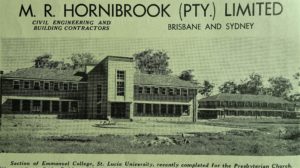
Advertisement by builders M.R. Hornibrook
On 19 May 1956 two thousand people, including the 80 students in residence, attended the official opening ceremony of the “new Emmanuel”. Sir Arthur Fadden, the Federal Treasurer who had also been Australia’s shortest-serving Prime Minister (for 40 days in 1941, between Robert Menzies’ resignation and John Curtin being sworn in), addressed the enthusiastic crowd:
“If ever we needed university colleges, we need them today — for in the corporate life of such magnificent institutes there is bred a richness of intellectual life and a moral force which equips those who graduate from them for life’s inevitable battles.”
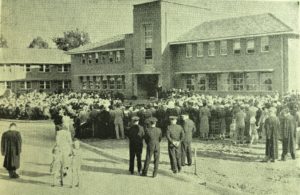
Official opening ceremony of the “new” Emmanuel College in 1956
Robert, known as Bob, Nicol was a student studying engineering at the time of the transition, and experienced College life on Wickham Terrace and at St Lucia. Despite the lovely new facilities, he remembers 1956 as “not the happiest year for students” due to the Principal’s concerns over possible damage to the splendid new buildings caused by young, high-spirited residents.
Principal Reverend Lancelot John Douglas had succeeded Principal Mervyn Henderson in 1955. “Beloved Prune”, as Henderson was affectionately known due to his wrinkled visage, had steered the good ship Emmanuel — or rather, given his passion for rowing, led at stroke — for 32 years. Douglas had been the lecturer in old testament at the Theological Hall and a member of the College Council prior to being appointed Principal. His consternation over Emmanuel’s water-fighting traditions and mission to stamp them out were clear.
Bob recalls with glee the water-bomb battles and freshers being dunked in the horse trough across the road from the College on Wickham Terrace and laments that these “high jinks” were “verboten” at the new Emmanuel due to Principal Douglas’ strict policies in relation to student goings-on. In 1958 Bob was voted Emmanuel College Students’ Club President and did his best to “steer a line between the students and the Principal”.
After he graduated, Bob was appointed senior residential tutor in 1959. The College tutorial system has always been key component of the academic life of Emmanuel. Indeed, the minutes of the first Council meeting in 1911 specify that “efficient tutorial assistance” is to be provided for students. There were two resident tutors in 1912 and in 1956 there were five. As Principal Douglas observed at the time, Emmanuel’s tutors “guide [students] in their studies, direct their reading, and assist with any specific problem arising … [this] helps first-year [students] to pass more readily from the secondary school stage of being taught to that of the University attending lectures”. Today, Emmanuel helps students achieve their academic potential through offering 80+ hours of tutorials each week, with subjects ranging from anatomy to zoology.
The 1950s came to a close at Emmanuel with 150 students in residence in 1959 and the opening of the College chapel in May of that year. The first wedding was held there in August 1959. The groom was none other than Bob Nicol and the bride was his long-term sweetheart Joyce. Following Bob’s marriage, Principal Douglas offered him the position of Vice Principal. An on-site house provided for Bob and Joyce “at no charge” clinched the deal. Somewhat ironically, Bob’s main duty was to maintain discipline (“and make sure no girls slept over at College”). Bob was transferred to Sydney for work a year later and his association with Emmanuel was in hiatus until he returned to Brisbane in the late 1980s. He served on the Council for 14 years, including as Chair from 1998 to 2000. In 2007 he was appointed as an Honorary Fellow of the College. The connections between Bob’s life and that of the College endure, and his sentiments are that of many alumni: “Emmanuel still means a lot to me”.
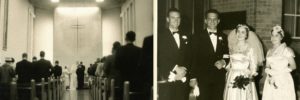
The wedding of Bob and Joyce Nicol in the Emmanuel College chapel 29 August 1959
The swinging ’60s whirled in. This socially turbulent decade saw the rise of counter culture, the sexual revolution, burgeoning movements for equality for women and the rights of Indigenous Australians, the Vietnam War and conscription and protests against both, drugs as recreation, man walking on the moon, pop art, miniskirts and Beatlemania.
Life within the safe haven of Emmanuel was relatively stable. Students enjoyed their new College, additional facilities and wings were built, and landscaping improvements were made throughout the campus. One of the major projects to enrich students’ lives was Emmanuel’s own boatshed and pontoon on the riverbank.

Emmanuel’s boatshed and pontoon in the early 1960s
Our sports teams enjoyed much success throughout this decade. Emmanuel dominated the inter-college sports, winning the ICC in 1960 and then for six consecutive years from 1963 to 1968 with many triumphs in rowing, rugby and cricket.

College champions: 1963 Rowing XIII, 1963 Rugby team, 1964 Cricketers
The Emmanuel College magazine of 1967 signals a social consciousness and a level of maturity among students. The essays therein address issues such as “colonial parochialism” and criticise the “puerile rites” of certain College “traditions”. Several articles by overseas students — who that year came from Fiji, Indonesia, Japan, Korea, Maylasia, Nepal, Pakistan, Singapore, Sweden and America —are included, with an acknowledgement of “the inestimable advantage of their presence in College”. The after-dinner speakers program covered a broad range of subjects to encourage “a diversification of thought”. Topics covered politics, science, religion, and the social, moral and reproductive aspects of sex.
As well as expanding students’ perspectives, Emmanuel’s physical expansion continued. By the end of the decade the number of students in residence, part of the baby boom generation, had increased to 220.
